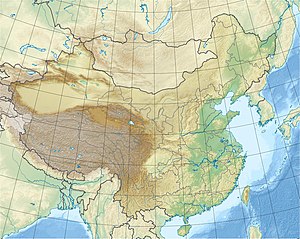
Back سانشينغدوي Arabic Sanxingdui Catalan Sanxingdui German Sanxingdui Esperanto Sanxingdui Spanish Sanxingdui French סאנשינגדואי HE Sanxingdui ID Sanxingdui Italian 三星堆遺跡 Japanese
30°59′35″N 104°12′00″E / 30.993°N 104.200°E
| Geographical range | Chengdu Plain | ||||||
|---|---|---|---|---|---|---|---|
| Period | Bronze Age China | ||||||
| Dates | c. 1700 – c. 1150 BC [1] | ||||||
| Type site | Sanxingdui | ||||||
| Major sites | Guanghan, Deyang | ||||||
| Preceded by | Baodun culture | ||||||
| Followed by | Jinsha Ba and Shu | ||||||
| Chinese name | |||||||
| Chinese | 三星堆文化 | ||||||
| |||||||

Sanxingdui (Chinese: 三星堆; pinyin: Sānxīngduī; lit. 'Three Star Mound') is an archaeological site and a major Bronze Age culture in modern Guanghan, Sichuan, China. Largely discovered in 1986,[2] following a preliminary finding in 1927,[3] archaeologists excavated artifacts that radiocarbon dating placed in the 12th-11th centuries BC.[4] The archaeological site is the type site for the Sanxingdui culture that produced these artifacts, archeologists have identified the locale with the ancient kingdom of Shu. The artifacts are displayed in the Sanxingdui Museum located near the city of Guanghan.[4]
Sanxingdui is on the UNESCO list of tentative World Heritage Sites, along with the Jinsha site and the tombs of boat-shaped coffins.[5]
- ^ Flad, Rowan; Chen, Pochan (2013). Ancient Central China: Centers and Peripheries Along the Yangtze River. New York: Cambridge University Press. pp. 89–90. ISBN 978-0-521-72766-2.
- ^ Mystery of Ancient Chinese Civilization's Disappearance Explained
- ^ Xu, Jay (2011). "Lithic Artifacts from Yueliangwan: Research Notes on an Early Discovery at the Sanxingduiu Site". In Jerome Silbergeld; Dora C. Y. Ching; Judith G. Smith; Alfreda Merck (eds.). Bridges to Heaven: Essays on East Asian Art in Honor of Professor Wen C. Fong, Volume I. Princeton, NJ: Princeton University Press. ISBN 978-0-691-15298-1.
- ^ a b Sage, Steven F. (1992). Ancient Sichuan and the unification of China. Albany: State University of New York Press. p. 16. ISBN 0791410374.
- ^ "Archaeological Sites of the Ancient Shu State: Site at Jinsha and Joint Tombs of Boat- shaped Coffins in Chengdu City, Sichuan Province; Site of Sanxingdui in Guanghan City, Sichuan Province 29C.BC-5C.BC". UNESCO. Retrieved 23 February 2018.


